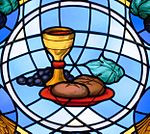Impanation
In this article, we will explore the exciting world of Impanation and all the facets that involve it. From its origins to its impact on today's society, Impanation is a topic that deserves detailed and thoughtful attention. Along these lines, we will analyze its relevance in different contexts, as well as the controversies and debates that surround it. With a critical and objective approach, we will delve into Impanation to understand its importance and challenges today. This article will undoubtedly provide a comprehensive overview of Impanation and leave the reader with a greater understanding and appreciation for this topic.
| Part of a series on the |
| Eucharist |
|---|
 |
Impanation (Latin: impanatio, "embodied in bread") is a high medieval theory of the real presence of the body of Jesus Christ in the consecrated bread of the Eucharist that does not imply a change in the substance of either the bread or the body. This doctrine, apparently patterned after Christ's Incarnation (God is made flesh in the Person of Jesus Christ), is the assertion that "God is made bread" in the Eucharist. Christ's divine attributes are shared by the eucharistic bread via his body. This view is similar but not identical to the theory of consubstantiation associated with Lollardy. It is considered a heresy by the Roman Catholic Church and is also rejected by classical Lutheranism. Rupert of Deutz (d. 1129) and John of Paris (d. 1306) were believed to have taught this doctrine.
See also
Groups associated with Impanation:
Notes
- ^ Wm. A. Neilson, ed., Webster's New International Dictionary of the English Language, second edition, (Springfield, MA: G. & C. Merriam Co., pub., 1936), 1247 sub loco: "the inclusion of the body of Christ in the Eucharistic bread and wine, conceived of as a union without change in any substance; distinguished from transubstantiation and consubstantiation."
- ^ John 1:14
- ^ a b Herbermann, Charles, ed. (1913). . Catholic Encyclopedia. New York: Robert Appleton Company.
- ^ Formula of Concord, Solid Declaration Article VII Archived 2008-11-21 at the Wayback Machine, 14–15, 64; cf. also Charles P. Krauth, The Conservative Reformation and Its Theology (Philadelplhia: J.B. Lippincott & Co., 1875), 771.
- This article incorporates text from a publication now in the public domain: Wood, James, ed. (1907). The Nuttall Encyclopædia. London and New York: Frederick Warne.
{{cite encyclopedia}}: Missing or empty|title=(help)
